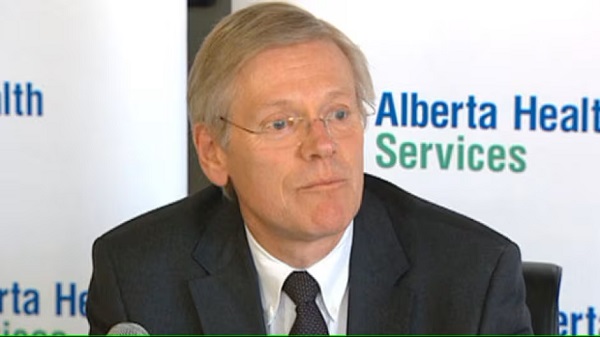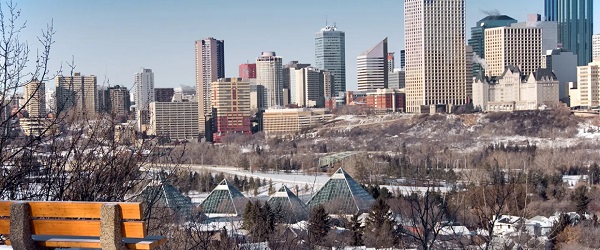Alberta
Former AHS head, Dr. Chris Eagle will lead Acute Care Alberta

Refocusing acute care leadership for the future
Alberta’s government is bringing in the expertise and experience needed to continue refocusing the health care system for the benefit of all Albertans.
Alberta’s government is committed to refocusing the health care system so that Albertans can access the health care services they need when and where they need them. The work to transform the system is making significant progress, particularly with the recent launch of Primary Care Alberta in November 2024, and the continued advancement in establishing Alberta’s new acute care provincial health agency.
Acute care, which includes hospitals, emergency services and surgery care, is a significant part of the health care system, providing critical care to Albertans when they need it most. Acute Care Alberta, the new acute care provincial health agency, will work to speed up access to high-quality care, reduce wait times and make sure the patient’s journey through the system is efficient and effective across the province.
As progress is made to establish Acute Care Alberta, Alberta’s government is appointing Dr. Chris Eagle as chair and interim president and CEO. This appointment will take effect Feb. 1 to coincide with the establishment of Acute Care Alberta as a legal entity. Dr. Eagle’s focus will be on preparing the organization for its first day of operations later this spring. His appointment to the position is pending finalization of his contract.
Dr. Eagle has significant experience supporting and leading health care organizations and projects across Alberta, including his time as president and CEO of Alberta Health Services (AHS) from 2010 to 2013. His extensive experience in the health field will allow him to guide the work to operationalize Acute Care Alberta.
To help support Dr. Eagle’s work and to lead AHS through its transition from a regional health authority to a hospital-based service provider, Andre Tremblay, deputy minister of Alberta Health, has been appointed interim president and CEO of AHS.
“Acute care is the most complex part of the health care system, and it’s critical that we have the right leadership in place to see this work through and make positive changes to the health care system for Albertans now and into the future. I want to extend my sincerest gratitude to Athana Mentzelopoulos for the work she has done during her time leading Alberta Health Services.”
Tremblay brings a wealth of public service and health care delivery experience to the position. With more than 20 years of public sector leadership, he has served in several senior leadership positions. Prior to joining Health in June 2023, Tremblay has been deputy minister at Education, Agriculture and Forestry, and Transportation. This is also his second leadership role at Alberta Health, having previously served as an associate deputy minister. He was also previously appointed as the deputy clerk of executive council and deputy secretary to cabinet. In his role as interim president and CEO, Tremblay will not receive a salary. His salary as deputy minister will remain the same.
Tremblay will continue as deputy minister through this critical period of transition and change for Alberta’s health care system. He will also oversee the recruitment of a permanent president and CEO for Acute Care Alberta. He is best positioned to continue leading efforts to refocus the health care system while supporting the transition of Alberta Health Services to an acute care service provider.
While in the interim role, Tremblay will work with AHS leadership to oversee operations, support staff transitions to Primary Care Alberta and establish Acute Care Alberta as a legal entity ahead of its operationalization this spring. Throughout this work, Albertans will continue to access acute care services as they always have and there will be no impact to front-line health care workers.
The AHS board of directors will begin the search for a permanent president and CEO immediately, and more details will be provided once the hiring process is complete.
“I am excited to take on this role and support the efforts to refocus Alberta’s health care system and to create an improved acute care system that will make sure Albertans have access to the best health care services they need, no matter where they live in the province.”
“We are at a critical time in the work that is underway to refocus the health care system. I am confident we can continue to make great strides to achieve the goal of making health care better for everyone in Alberta. I want to thank Athana Mentzelopoulos for her hard work, commitment and leadership during her time in the role.”
“We have made great progress refocusing the health care system and I am eager to take on this new role and support the work being done to improve health care across the province. I look forward to leading AHS as it transitions to a service delivery provider and engaging with front-line workers and staff across the system in the coming months.”
Alberta
Alberta’s new diagnostic policy appears to meet standard for Canada Health Act compliance

From the Fraser Institute
By Nadeem Esmail, Mackenzie Moir and Lauren Asaad
In October, Alberta’s provincial government announced forthcoming legislative changes that will allow patients to pay out-of-pocket for any diagnostic test they want, and without a physician referral. The policy, according to the Smith government, is designed to help improve the availability of preventative care and increase testing capacity by attracting additional private sector investment in diagnostic technology and facilities.
Unsurprisingly, the policy has attracted Ottawa’s attention, with discussions now taking place around the details of the proposed changes and whether this proposal is deemed to be in line with the Canada Health Act (CHA) and the federal government’s interpretations. A determination that it is not, will have both political consequences by being labeled “non-compliant” and financial consequences for the province through reductions to its Canada Health Transfer (CHT) in coming years.
This raises an interesting question: While the ultimate decision rests with Ottawa, does the Smith government’s new policy comply with the literal text of the CHA and the revised rules released in written federal interpretations?
According to the CHA, when a patient pays out of pocket for a medically necessary and insured physician or hospital (including diagnostic procedures) service, the federal health minister shall reduce the CHT on a dollar-for-dollar basis matching the amount charged to patients. In 2018, Ottawa introduced the Diagnostic Services Policy (DSP), which clarified that the insured status of a diagnostic service does not change when it’s offered inside a private clinic as opposed to a hospital. As a result, any levying of patient charges for medically necessary diagnostic tests are considered a violation of the CHA.
Ottawa has been no slouch in wielding this new policy, deducting some $76.5 million from transfers to seven provinces in 2023 and another $72.4 million in 2024. Deductions for Alberta, based on Health Canada’s estimates of patient charges, totaled some $34 million over those two years.
Alberta has been paid back some of those dollars under the new Reimbursement Program introduced in 2018, which created a pathway for provinces to be paid back some or all of the transfers previously withheld on a dollar-for-dollar basis by Ottawa for CHA infractions. The Reimbursement Program requires provinces to resolve the circumstances which led to patient charges for medically necessary services, including filing a Reimbursement Action Plan for doing so developed in concert with Health Canada. In total, Alberta was reimbursed $20.5 million after Health Canada determined the provincial government had “successfully” implemented elements of its approved plan.
Perhaps in response to the risk of further deductions, or taking a lesson from the Reimbursement Action Plan accepted by Health Canada, the province has gone out of its way to make clear that these new privately funded scans will be self-referred, that any patient paying for tests privately will be reimbursed if that test reveals a serious or life-threatening condition, and that physician referred tests will continue to be provided within the public system and be given priority in both public and private facilities.
Indeed, the provincial government has stated they do not expect to lose additional federal health care transfers under this new policy, based on their success in arguing back previous deductions.
This is where language matters: Health Canada in their latest CHA annual report specifically states the “medical necessity” of any diagnostic test is “determined when a patient receives a referral or requisition from a medical practitioner.” According to the logic of Ottawa’s own stated policy, an unreferred test should, in theory, be no longer considered one that is medically necessary or needs to be insured and thus could be paid for privately.
It would appear then that allowing private purchase of services not referred by physicians does pass the written standard for CHA compliance, including compliance with the latest federal interpretation for diagnostic services.
But of course, there is no actual certainty here. The federal government of the day maintains sole and final authority for interpretation of the CHA and is free to revise and adjust interpretations at any time it sees fit in response to provincial health policy innovations. So while the letter of the CHA appears to have been met, there is still a very real possibility that Alberta will be found to have violated the Act and its interpretations regardless.
In the end, no one really knows with any certainty if a policy change will be deemed by Ottawa to run afoul of the CHA. On the one hand, the provincial government seems to have set the rules around private purchase deliberately and narrowly to avoid a clear violation of federal requirements as they are currently written. On the other hand, Health Canada’s attention has been aroused and they are now “engaging” with officials from Alberta to “better understand” the new policy, leaving open the possibility that the rules of the game may change once again. And even then, a decision that the policy is permissible today is not permanent and can be reversed by the federal government tomorrow if its interpretive whims shift again.
The sad reality of the provincial-federal health-care relationship in Canada is that it has no fixed rules. Indeed, it may be pointless to ask whether a policy will be CHA compliant before Ottawa decides whether or not it is. But it can be said, at least for now, that the Smith government’s new privately paid diagnostic testing policy appears to have met the currently written standard for CHA compliance.

Lauren Asaad
Policy Analyst, Fraser Institute
Alberta
Housing in Calgary and Edmonton remains expensive but more affordable than other cities

From the Fraser Institute
By Tegan Hill and Austin Thompson
In cities across the country, modest homes have become unaffordable for typical families. Calgary and Edmonton have not been immune to this trend, but they’ve weathered it better than most—largely by making it easier to build homes.
Specifically, faster permit approvals, lower municipal fees and fewer restrictions on homebuilders have helped both cities maintain an affordability edge in an era of runaway prices. To preserve that edge, they must stick with—and strengthen—their pro-growth approach.
First, the bad news. Buying a home remains a formidable challenge for many families in Calgary and Edmonton.
For example, in 2023 (the latest year of available data), a typical family earning the local median after-tax income—$73,420 in Calgary and $70,650 in Edmonton—had to save the equivalent of 17.5 months of income in Calgary ($107,300) or 12.5 months in Edmonton ($73,820) for a 20 per cent down payment on a typical home (single-detached house, semi-detached unit or condominium).
Even after managing such a substantial down payment, the financial strain would continue. Mortgage payments on the remaining 80 per cent of the home’s price would have required a large—and financially risky—share of the family’s after-tax income: 45.1 per cent in Calgary (about $2,757 per month) and 32.2 per cent in Edmonton (about $1,897 per month).
Clearly, unless the typical family already owns property or receives help from family, buying a typical home is extremely challenging. And yet, housing in Calgary and Edmonton remains far more affordable than in most other Canadian cities.
In 2023, out of 36 major Canadian cities, Edmonton and Calgary ranked 8th and 14th, respectively, for housing affordability (relative to the median after-tax family income). That’s a marked improvement from a decade earlier in 2014 when Edmonton ranked 20th and Calgary ranked 30th. And from 2014 to 2023, Edmonton was one of only four Canadian cities where median after-tax family income grew faster than the price of a typical home (in Calgary, home prices rose faster than incomes but by much less than in most Canadian cities). As a result, in 2023 typical homes in Edmonton cost about half as much (again, relative to the local median after-tax family income) as in mid-sized cities such as Windsor and Kelowna—and roughly one-third as much as in Toronto and Vancouver.
To be clear, much of Calgary and Edmonton’s improved rank in affordability is due to other cities becoming less and less affordable. Indeed, mortgage payments (as a share of local after-tax median income) also increased since 2014 in both Calgary and Edmonton.
But the relative success of Alberta’s two largest cities shows what’s possible when you prioritize homebuilding. Their approach—lower municipal fees, faster permit approvals and fewer building restrictions—has made it easier to build homes and helped contain costs for homebuyers. In fact, homebuilding has been accelerating in Calgary and Edmonton, in contrast to a sharp contraction in Vancouver and Toronto. That’s a boon to Albertans who’ve been spared the worst excesses of the national housing crisis. It’s also a demographic and economic boost for the province as residents from across Canada move to Alberta to take advantage of the housing market—in stark contrast to the experience of British Columbia and Ontario, which are hemorrhaging residents.
Alberta’s big cities have shown that when governments let homebuilders build, families benefit. To keep that advantage, policymakers in Calgary and Edmonton must stay the course.
-

 Business2 days ago
Business2 days agoTaxing food is like slapping a surcharge on hunger. It needs to end
-

 Health1 day ago
Health1 day agoFDA warns ‘breast binder’ manufacturers to stop marketing to gender-confused girls
-

 International1 day ago
International1 day ago2025: The Year The Narrative Changed
-

 Business1 day ago
Business1 day agoThere’s No Bias at CBC News, You Say? Well, OK…
-

 Energy2 days ago
Energy2 days ago75 per cent of Canadians support the construction of new pipelines to the East Coast and British Columbia
-

 Health2 days ago
Health2 days agoAll 12 Vaccinated vs. Unvaccinated Studies Found the Same Thing: Unvaccinated Children Are Far Healthier
-

 Agriculture1 day ago
Agriculture1 day agoSupply Management Is Making Your Christmas Dinner More Expensive
-

 Daily Caller1 day ago
Daily Caller1 day agoTrump Reportedly Escalates Pressure On Venezuela With Another Oil Tanker Seizure













